We may not have the course you’re looking for. If you enquire or give us a call on + 1-866 272 8822 and speak to our training experts, we may still be able to help with your training requirements.
Training Outcomes Within Your Budget!
We ensure quality, budget-alignment, and timely delivery by our expert instructors.
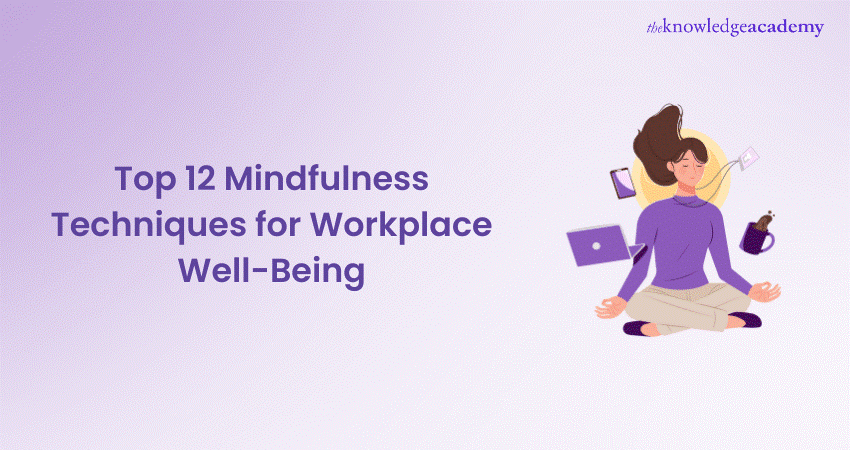
The modern workplace is often a hub of fast-paced activity, demanding schedules, and high-stress environments. In the pursuit of success, it's easy to lose sight of the present moment and become overwhelmed by the many demands of work. This is where Mindfulness Exercises and Techniques step in, offering a path to increased productivity, stress reduction, and overall well-being right within the professional setting.
According to Statista, in Great Britain alone, about 875,000 people suffer from work-related stress. So, it is a major problem that can have serious consequences if not dealt with properly. By using proper Mindfulness Techniques, you can overcome this problem. If you are interested in learning more about it, then this blog is for you.
In this blog, you will learn about the Top 15 Mindfulness Exercises and Techniques to Practice at Work. Let's delve in deeper to learn more about it!
Table of Contents
1) Introduction to Mindfulness
2) Benefits of Mindfulness
3) Four Mindfulness Exercise to Practice
4) Eleven Mindfulness Techniques to Practice
5) Conclusion
Introduction to Mindfulness
Mindfulness involves being completely conscious and in the present moment, without judgment. Based on ancient meditation practices, Mindfulness aids in increasing awareness of one's thoughts, feelings, and environment. This increased awareness promotes feelings of tranquillity, leading to improved emotional control and stress relief. Practising Mindfulness through meditation, breathing techniques, or being fully aware of everyday tasks helps develop a stronger bond with the present moment, enhancing mental clarity.
Integrating Mindfulness into everyday activities has positively affected general health and happiness. Research indicates it can alleviate anxiety, boost concentration, and strengthen emotional resilience. Training the mind to remain in the present moment through Mindfulness promotes increased self-awareness and empathy. By engaging in Mindful practices, people acquire important skills to help them overcome life's difficulties more smoothly, allowing them to uphold a harmonious and optimistic outlook.
Harness the power of mindfulness to foster inner peace with our Mindfulness Training – Sign up now!
Benefits of Mindfulness
Now that we've introduced the concept of Mindfulness , it's imperative to understand the significant advantages they bring to the workplace. These benefits extend far beyond mere stress reduction, touching upon multiple facets of professional life, ultimately contributing to a more balanced and fulfilling work experience. Let’s explore them below:
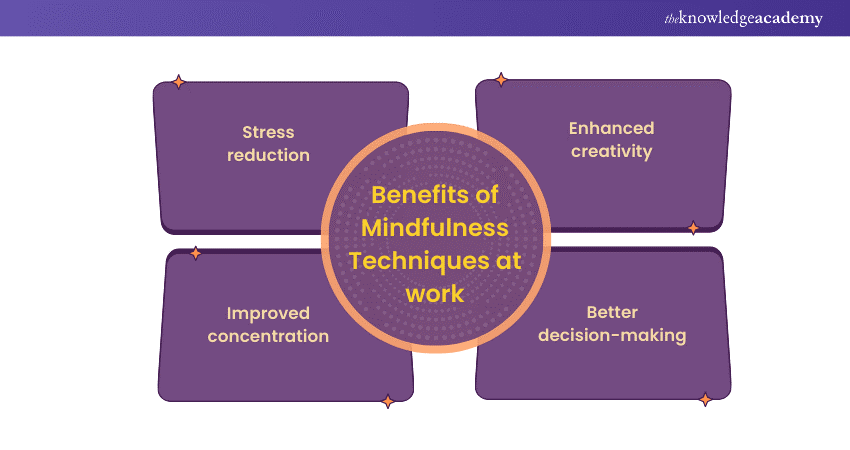
1) Stress Reduction: Mindfulness Exercises and Techniques are renowned for their stress-reduction capabilities. By practising Mindfulness, you can better manage work-related stress, enhancing your overall well-being and job performance.
2) Improved Concentration: Mindfulness cultivates the ability to focus on the task at hand. In a world filled with distractions, this heightened concentration empowers you to complete tasks more efficiently.
3) Enhanced Creativity: As your mind becomes more attuned to the present moment, it frees up space for creativity to flourish. Mindfulness encourages a clear, open mindset conducive to innovative thinking.
4) Better Decision-making: In the chaos of a busy workday, the ability to make well-informed, rational decisions is a precious skill. Mindfulness helps you achieve this by providing a foundation of emotional balance and clarity.
These are just a few of the notable advantages of Mindfulness at work. In the subsequent sections, we'll explore specific Mindfulness Techniques that can be employed to attain these benefits and more, making your work life more satisfying and productive.
Four Mindfulness Exercise to Practice
A Mindfulness Exercise is a concentrated practice that enhances your awareness significantly. Here are 4 Mindfulness Exercises you can practice easily.
1) The Raisin Exercise
The Raisin Exercise is an easy Mindfulness practice suitable for beginners. Any food can be used, but one with a unique texture, scent, or flavour is most effective. Attendees are provided with raisins and requested to envision a scenario in which they have never encountered them before. Their attention is directed towards observing the raisin's visual characteristics, texture, tactile sensation, scent, and flavour.
Individuals direct their focus to the current time by focusing completely on the raisin, minimising interruptions and concerns. They gently redirect their mind back to the exercise when the mind wanders.
2) The Body Scan
The Body Scan is a well-known Mindfulness practice that can be started easily with few resources, making it suitable for beginners. Participants can either lie on their backs with palms facing up and their feet relaxed or sit comfortably with their feet placed on the floor.
The instructor leads participants to stay in place, concentrating on their breathing without changing it. The focus then shifts to the body—its sensations, the texture of clothing, and its connection with the surface. The survey systematically progresses from the feet to the head, identifying tight or numb areas. After completion, participants will gently return to a seated position.
3) Mindful Seeing
A lack of visual stimuli can prevent Mindfulness for certain individuals. The Mindful Seeing activity provides a useful remedy, needing just a window to look out of. Individuals are led through easy procedures, which are as follows:
Step 1: Locate a window with a clear view of the surroundings
Step 2: Look at things without categorising them—pay attention to the colours, designs, and feels rather than naming what they are
Step 3: Observe the motion, forms, and details as though seeing them anew
Step 4: Remain watchful without turning judgmental or obsessing
Step 5: If you find yourself distracted, simply redirect your focus back to colour or shape
This activity promotes Mindfulness by urging a new, non-judgmental outlook.
4) Mindful Listening
This exercise presents Mindful listening as a group activity. Practising attentive listening is an important ability that enables people to concentrate on others without interruptions or criticisms, promoting effective communication and establishing a feeling of being acknowledged and understood.
Mindful Listening exercise consists of the following steps:
Step 1: Participants consider one source of stress and one aspect they anticipate
Step 2: Every individual contributes their opinions to the group
Step 3: Participants weigh the sensation of expressing and sharing both enjoyable and anxiety-inducing experiences
Step 4: While speaking and listening, they pay attention to their thoughts, emotions, and bodily sensations
Step 5: Following the sharing session, divide into smaller groups to discuss reflection questions like: What were your emotions during speaking and listening? Did your thoughts drift or criticise? What was the sensation of empathy like?
This activity promotes Mindfulness and fosters compassion, improving interpersonal interactions and communication skills. Adding activities such as yoga or Qigong can enhance this experience even more.
Eleven Mindfulness Techniques to Practice
This section will discuss the Top 11 Mindfulness Techniques for the workplace. Let’s explore them all in detail:
1) Set an Intention
Beginning your workday with a specific goal in mind can help you concentrate and have a positive attitude towards your tasks. This thoughtful strategy assists in harmonising your objectives with intentional behaviours, providing significance and guidance to your tasks.
How to Practice:
a) Morning Reflection: Start your morning with a reflection on what you hope to achieve and how you plan to tackle your to-do list.
b) Prioritisation: Recognise the crucial tasks that support your objectives and concentrate on finishing them as a top priority.
c) Focus and Commitment: Remind yourself gently of your intentions to stay on track and committed throughout the day.
d) Eliminate Distractions: Reduce distractions by setting up a environment free from interruptions to stay focused and connected to your goals.
e) Mindful Planning: Arrange your day with care, making sure to allocate time for tasks that align with your goals.
Adding this habit to your daily schedule will enhance the clarity and direction of your career.
2) Make Your Work Meaningful
Infusing purpose into your job can greatly boost Mindfulness at work. Assigning meaning and intent to your everyday chores can transform mundane duties into satisfying moments, ultimately benefiting your mental well-being. Here are some ways to nurture a sense of purpose:
a) Reflect on Your Values: Dedicate some time to pinpointing your fundamental values and examining how they relate to your job. Recognising these links can assist you in uncovering greater meaning in your responsibilities.
b) Align Your Goals: Make sure your career goals align with your personal ambitions. This alignment assists in connecting your work life and personal life.
c) Emphasise Positive Impact: Concentrate on the constructive impact your work has on others, be it your coworkers, customers, or the broader society. Acknowledging this influence can boost your feeling of purpose.
d) Embrace Continuous Learning: Embrace the mindset of continuous learning by seeing challenges as chances to gain knowledge and grow. This point of view adds depth and value to your career experience.
e) Practice Gratitude: Consistently recognise and show appreciation for the experiences and opportunities provided by your job. This habit encourages an optimistic perspective and enhanced gratitude for your position.
By putting these tactics into practice, you can turn your job into a fulfilling endeavor, fostering awareness and enhancing job contentment.
3) Be Consciously Present
Fully engage in your professional activities to promote Mindfulness at work. This method assists in staying concentrated and clear-minded without being bothered by distractions or unnecessary mental chatter. Here are some tips for practising it:
a) Breathe Mindfully: Pause and ground yourself by concentrating on your breathing before starting a new project.
b) Eliminate Multitasking: Refrain from multitasking; commit your focus to one task at a time to completely engage in the work.
c) Mindful Awareness: Periodically check in with yourself to ensure you are present and focused throughout the day, staying connected to the moment.
d) Set Mindful Reminders: Develop Mindful reminders such as visual cues or alarms to prompt brief moments of Mindfulness throughout your workday.
e) Mindful Listening: When interacting with coworkers or clients, be fully present and attentively listen to what they have to say.
By implementing these methods, you can develop a stronger feeling of being in the moment at work, improving your concentration and general Mindfulness.
4) Meditation Breaks
Adding brief meditation sessions to your daily work routine is a great way to refresh your mind, reduce stress, and improve your overall health. These brief periods of Mindfulness provide a rejuvenating break from the usual routine, aiding in the preservation of your concentration and vitality. Here are some tips for practising it:
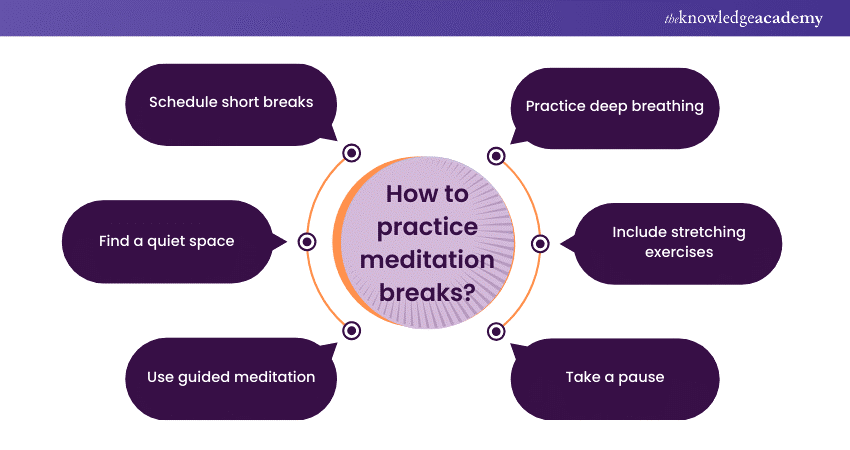
a) Schedule Short Breaks: Plan brief pauses in your daily schedule for meditation, giving yourself these important breaks.
b) Find a Quiet Space: Search for a peaceful area to meditate in solitude, establishing a serene environment free from disturbances.
c) Use Guided Meditation: Utilise meditation apps or online tools to assist in guiding your meditation practice, aiding in maintaining focus.
d) Practice Deep Breathing: Practice deep, Mindful breathing exercises during your breaks to calm your mind and body.
e) Incorporate Stretching: Include stretching exercises to relieve physical tension, improving your overall comfort.
f) Take a Pause: Take a few minutes to focus, declutter your mind, and recharge before resuming your activities.
Taking breaks for meditation during work can help you relax and recharge, ultimately enhancing focus and productivity.
5) Single-tasking
Single-tasking stresses the significance of giving all your focus to one task rather than dividing your attention between various activities. Focusing intensely on one task can improve both your efficiency and the overall excellence of your output. Follow the steps to implement single-tasking:
a) Identify Priorities: Recognise what tasks are the most important and focus all of your attention on completing them.
b) Use Time Blocks: Reserve designated time periods for individual tasks, focusing exclusively on one task within each interval.
c) Eliminate Distractions: Remove potential distractions by setting up a workspace that helps you concentrate on one task at a time.
d) Complete Tasks Before Moving On: Ensure tasks are completed before starting new ones to boost feelings of accomplishment and focus.
e) Practice Mindful Transitions: Be aware of transitions between tasks, and make sure to stay fully present in every moment.
Focusing on one task at a time can result in improved work quality and productivity, as well as reducing the stress associated with juggling multiple tasks.
Unlock a brighter tomorrow with our Mental Health Training – Sign up today!
6) Growth Mindset
Having a growth mindset is crucial for promoting Mindfulness in the workplace, enabling individuals to tackle challenges with excitement and see failures as opportunities for growth. By adopting this mentality, you can explore fresh opportunities and uphold an optimistic outlook in your career path. It is seen as a highly effective Mindfulness method that allows you to push your boundaries and transform setbacks into opportunities for achievement.
Tips for Developing a Growth Mindset
a) Embrace Challenges: Embrace challenges by seeing them as chances for personal and professional development, welcoming new experiences into your professional journey.
b) Learn from Mistakes: View mistakes as valuable lessons that lead to growth and progress.
c) Stay Resilient: Develop resilience to confront challenges with perseverance and adaptability, enabling you to recover more effectively.
d) Commit to Ongoing Learning: Make a commitment to continuously learning and improving yourself, both professionally and personally.
e) Practice Positive Self-talk: Substituting negative self-beliefs with empowering affirmations that promote growth and self-assurance.
f) Set Stretch Goals: Establish ambitious objectives that push you beyond your comfort zone, encouraging growth in both your personal and professional life.
By adopting a growth mindset, you enable yourself to excel in challenges, create new ideas successfully, and advance consistently in your profession.
Lead with compassion with our Work Place Stress And Mental Health Identification For Manager – Sign up now!
7) Embrace Feelings
Engaging in Mindfulness at work involves acknowledging and embracing your emotions rather than ignoring them. This method aids in cultivating a more profound comprehension of your emotions, promoting Emotional Intelligence and improving your overall work environment.
Tips for Cultivating Mindfulness with Feelings
a) Self-reflection: Take some time for self-reflection to recognise and understand your emotions, forming a stronger bond with yourself.
b) Non-judgmental Awareness: Practice non-judgmental awareness by adopting a mindset that accepts your feelings, allowing yourself to feel them without criticism.
c) Effective Expression: Efficiently communicate by expressing your feelings to coworkers and managers as needed, fostering open dialogue and enhancing professional connections.
d) Emotional Regulation: Learn methods to control intense feelings so they do not disrupt your effectiveness.
e) Seek Support: When necessary, ask a mentor, counsellor, or friend for advice on managing difficult emotions.
By accepting your feelings in the workplace, you can boost your Emotional Intelligence, enhance relationships with colleagues, and promote a more harmonious work setting.
8) Mindful Eating
Mindful eating goes beyond just eating at the table; it can greatly improve your time at work. Enjoying your meals Mindfully with breaks can enhance your overall well-being, increase focus, and promote a healthier connection with food.
Tips for incorporating Mindfulness into your workday while eating:
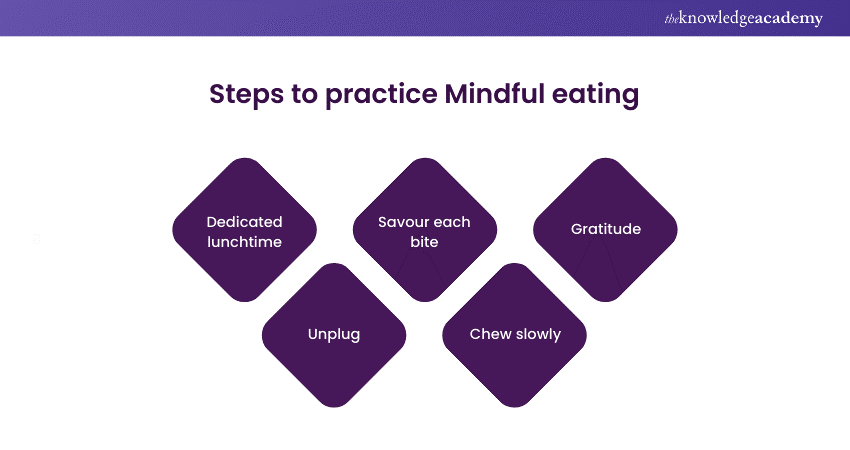
a) Set a Lunchtime Schedule: Designate a certain timeframe for lunch, making sure it is uninterrupted by work responsibilities or interruptions.
b) Disconnect from Devices: When you take meal breaks, avoid using electronic devices and focus on fully experiencing your meal.
c) Savour Every Bite: Enjoy the taste, feel, and scent of your food, fully savouring every bite.
d) Chew Slowly: Make sure to chew each bite thoroughly, as this can help with digestion and make you feel more satisfied.
e) Cultivate Gratitude: Recognise the nourishment your food offers and the chance to pause for yourself.
Integrating Mindful eating during your workday can improve your physical well-being, reduce stress, and offer moments of Mindfulness in a hectic schedule.
9) Stretching
Adding stretching to your work schedule is crucial for physical health and for cultivating Mindfulness. Stretching regularly not only relieves physical tension but also boosts relaxation and improves overall comfort all day long. It is an effective method for handling stress.
Ways to Include Stretching:
a) Desk Stretches: Do desk stretches by performing easy stretches while sitting at your desk, targeting areas such as your neck, shoulders, and wrists.
b) Full-body Stretch: Perform full-body stretches during short breaks to improve blood circulation and reduce stiffness.
c) Deep Breathing: Combine deep, mindful breathing with your stretching routine to experience a rejuvenating and soothing impact.
d) Mindful Breaks: Utilise stretching during Mindful breaks to transform them into opportunities for physical rejuvenation.
e) Ergonomic Awareness: Make sure your work area is designed to be comfortable and foster your overall health.
Incorporating stretching into your daily routine can reduce physical pain, improve overall health, and promote a greater sense of relaxation during work hours.
10) Gratitude Practices
Adopting a gratitude attitude is a powerful Mindfulness method that can significantly improve your workplace happiness. Acknowledging your successes and valuing the assistance you receive at the workplace will help foster a positive outlook that enhances your career.
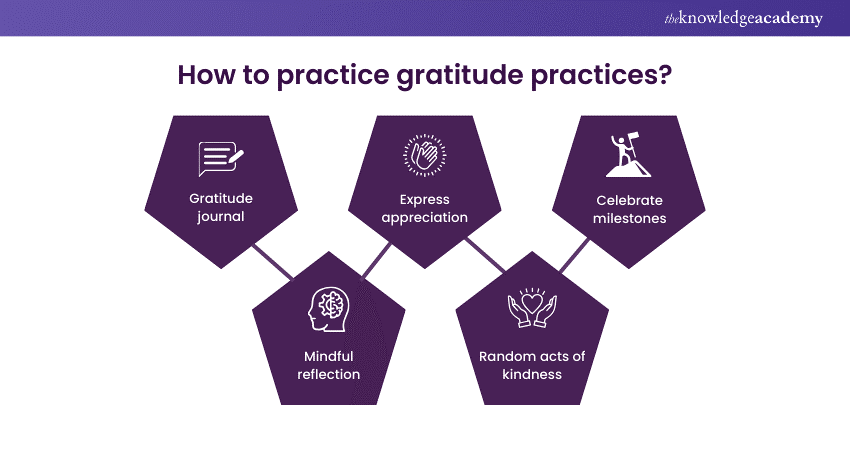
Tips on Practice Gratitude:
a) Keep a Gratitude Journal: Keep a gratitude journal to jot down daily achievements, good interactions, and things you appreciate.
b) Show Appreciation: Whether through words or written notes, show appreciation to coworkers, managers, and customers for their help and input.
c) Reflect Mindfully: Practice Mindful reflection by regularly pausing to consider the positive elements of your job and the potential it offers.
d) Celebrate Achievements: Acknowledge and celebrate both minor and major milestones and achievements.
e) Perform Kind Acts: Support a culture of gratitude and generosity in the workplace by performing random acts of kindness.
By integrating gratitude activities into your professional life, you can enhance your mood, enhance your connections with others, and feel more fulfilled in your work.
11) Mindful Breathing
Mindful breathing, an essential practice in Mindfulness, can easily be incorporated into your daily work routine. Focusing on your breath creates a feeling of peace, reduces stress, and enhances Mindfulness of the present.
Techniques for Practicing
a) Start Your Day with Intention: Set aside a few minutes at the start of your workday for focused breathing to cultivate a positive and balanced mindset.
b) Periodic Check-ins: Regularly pause during the day to focus on your breathing, which will help you stay centred and clear.
c) Stress Relief: When you experience stress or feel overwhelmed, use Mindful breathing to restore calmness and composure.
d) Deep, Diaphragmatic Breaths: Take deep breaths using your diaphragm to calm your body and mind, promoting a sense of peace.
e) Tune Into Your Breath: Observe the feelings connected to your breath—experience the chest expanding and contracting, the refreshing inhales, and the comforting exhales.
Incorporating Mindful breathing into your work schedule is a simple yet powerful method for decreasing stress and improving concentration, enabling you to stay peaceful during a busy day.
Conclusion
We hope you read and understand the top Mindfulness Techniques and How to practice them. From setting intentions to mindful breathing, they empower individuals to thrive in the modern workplace, finding greater productivity, resilience, and contentment. So, let's embrace and apply them in our daily routine.
Enhance your emotional awareness with our Mindfulness Training – Join now!
Frequently Asked Questions

The three R’s of Mindfulness include Recognise, Release, and Redirect. Start by assessing your thoughts and emotions, releasing any judgment, and then redirecting your focus to the present moment. This will encourage a more peaceful and concentrated mind.

The four C’s of Mindfulness include Curiosity, Courage, Compassion, & Connection. Curiosity fosters exploration of experience, while Courage helps you face challenges. On the other hand, Compassion will make you a kind being and Connection will help you build relationships.

The Knowledge Academy takes global learning to new heights, offering over 30,000 online courses across 490+ locations in 220 countries. This expansive reach ensures accessibility and convenience for learners worldwide.
Alongside our diverse Online Course Catalogue, encompassing 19 major categories, we go the extra mile by providing a plethora of free educational Online Resources like News updates, Blogs, videos, webinars, and interview questions. Tailoring learning experiences further, professionals can maximise value with customisable Course Bundles of TKA.

The Knowledge Academy’s Knowledge Pass, a prepaid voucher, adds another layer of flexibility, allowing course bookings over a 12-month period. Join us on a journey where education knows no bounds.

The Knowledge Academy offers various Mental Health Courses, including the Mindfulness Training, Mental Health And Wellbeing Training, and Handle Stress And Develop Your Resilience. These courses cater to different skill levels, providing comprehensive insights into Emotional Wellbeing.
Our Health & Safety Blogs cover a range of topics related to Mindfulness, offering valuable resources, best practices, and industry insights. Whether you are a beginner or looking to advance your Health & Safety skills, The Knowledge Academy's diverse courses and informative blogs have got you covered.
Upcoming Health & Safety Resources Batches & Dates
Date
 Mental Health and Wellbeing Training
Mental Health and Wellbeing Training
Fri 10th Jan 2025
Fri 14th Feb 2025
Fri 11th Apr 2025
Fri 23rd May 2025
Fri 8th Aug 2025
Fri 26th Sep 2025
Fri 21st Nov 2025







 Top Rated Course
Top Rated Course



 If you wish to make any changes to your course, please
If you wish to make any changes to your course, please


